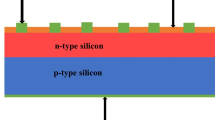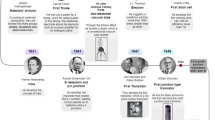Abstract
We describe Simudo, a free Poisson/drift-diffusion steady state device model for semiconductor and intermediate band materials, including self-consistent optical absorption and generation. Simudo is the first freely available device model that can treat intermediate band materials. Simudo uses the finite element method (FEM) to solve the coupled nonlinear partial differential equations in two dimensions, which is different from the standard choice of the finite volume method in essentially all commercial semiconductor device models. We present the continuous equations that Simudo solves, show the FEM formulations we have developed, and demonstrate how they allow robust convergence with double-precision floating point arithmetic. With a benchmark semiconductor pn junction device, we show that Simudo has a higher rate of convergence than Synopsys Sentaurus, converging to high accuracy with a considerably smaller mesh. Simudo includes many semiconductor phenomena and parameters and is designed for extensibility by the user to include many physical processes.










Similar content being viewed by others
Notes
In the BDM space, the normal fluxes are shared by adjacent elements. The flux exiting the perimeter of a collection of cells exactly equals the sum of fluxes out of each of the cells, with exact arithmetic.
relative to \(|w_{k}|/(\text {mesh size})\)
References
Bank, R.E., Rose, D.J., Fichtner, W.: Numerical methods for semiconductor device simulation. IEEE Trans. Electron Devices 30(9), 1031 (1983)
Fichtner, W., Rose, D., Bank, R.: Semiconductor device simulation. IEEE Trans. Electron Devices 30(9), 1018 (1983)
Markowich, P.A.: The Stationary Semiconductor Device Equations. Computational Microelectronics. Springer, Vienna (1986)
Piprek, J. (ed.): Handbook of Optoelectronic Device Modeling & Simulation. CRC Press, Boca Raton (2018)
Schenk, A.: Advanced Physical Models for Silicon Device Simulation. Springer, Wien (1998)
Luque, A., Martí, A.: Increasing the efficiency of ideal solar cells by photon induced transitions at intermediate levels. Phys. Rev. Lett. 78(26), 5014 (1997)
Okada, Y., Ekins-Daukes, N.J., Kita, T., Tamaki, R., Yoshida, M., Pusch, A., Hess, O., Phillips, C.C., Farrell, D.J., Yoshida, K., Ahsan, N., Shoji, Y., Sogabe, T., Guillemoles, J.F.: Intermediate band solar cells: recent progress and future directions. Appl. Phys. Rev. 2(2), 021302 (2015)
Mailoa, J.P., Akey, A.J., Simmons, C.B., Hutchinson, D., Mathews, J., Sullivan, J.T., Recht, D., Winkler, M.T., Williams, J.S., Warrender, J.M., Persans, P.D., Aziz, M.J., Buonassisi, T.: Room-temperature sub-band gap optoelectronic response of hyperdoped silicon. Nat. Commun. 5, 3011 (2014)
Berencén, Y., Prucnal, S., Liu, F., Skorupa, I., Hübner, R., Rebohle, L., Zhou, S., Schneider, H., Helm, M., Skorupa, W.: Room-temperature short-wavelength infrared Si photodetector. Sci. Rep. 7, 43688 (2017)
Wang, M., Berencén, Y., García-Hemme, E., Prucnal, S., Hübner, R., Yuan, Y., Xu, C., Rebohle, L., Böttger, R., Heller, R., Schneider, H., Skorupa, W., Helm, M., Zhou, S.: Extended infrared photoresponse in Te-hyperdoped Si at room temperature. Phys. Rev. Appl. 10(2), 024054 (2018)
Brown, A.S., Green, M.A.: Impurity photovoltaic effect: fundamental energy conversion efficiency limits. J. Appl. Phys. 92(3), 1329 (2002)
Martí, A., Antolín, E., Stanley, C.R., Farmer, C.D., López, N., Díaz, P., Cánovas, E., Linares, P.G., Luque, A.: Production of photocurrent due to intermediate-to-conduction-band transitions: a demonstration of a key operating principle of the intermediate-band solar cell. Phys. Rev. Lett. 97(24), 247701 (2006)
Wang, W., Lin, A.S., Phillips, J.D.: Intermediate-band photovoltaic solar cell based on ZnTe:O. Appl. Phys. Lett. 95(1), 011103 (2009)
López, N., Reichertz, L.A., Yu, K.M., Campman, K., Walukiewicz, W.: Engineering the electronic band structure for multiband solar cells. Phys. Rev. Lett. 106(2), 028701 (2011)
Sullivan, J.T., Simmons, C.B., Buonassisi, T., Krich, J.J.: Targeted search for effective intermediate band solar cell materials. IEEE J. Photovolt. 5(1), 212 (2015)
der Maur, M.A.: A multiscale simulation environment for electronic and optoelectronic devices. Ph.D. thesis, Universita’ degli Studi di Roma Tor Vergata (2008)
Birner, S., Zibold, T., Andlauer, T., Kubis, T., Sabathil, M., Trellakis, A., Vogl, P.: Nextnano: General purpose 3-D simulations. IEEE Trans. Electron Devices 54(9), 2137 (2007)
Clugston, D.A., Basore, P.A.: PC1D version 5: 32-bit solar cell modeling on personal computers. In: Twenty Sixth IEEE Photovoltaic Specialists Conference, pp. 207–210 (1997)
Haug, H., Greulich, J.: PC1Dmod 6.2-improved simulation of c-Si devices with updates on device physics and user interface. Energy Procedia 92(1876), 60 (2016)
Varache, R., Leendertz, C., Gueunier-Farret, M., Haschke, J., Muñoz, D., Korte, L.: Investigation of selective junctions using a newly developed tunnel current model for solar cell applications. Sol. Energy Mater. Sol. Cells 141, 14 (2015)
Burgelman, M., Nollet, P., Degrave, S.: Modelling polycrystalline semiconductor solar cells. Thin Solid Films 361–362, 527 (2000)
Alonso-Álvarez, D., Wilson, T., Pearce, P., Führer, M., Farrell, D., Ekins-Daukes, N.: Solcore: a multi-scale, Python-based library for modelling solar cells and semiconductor materials. J. Comput. Electron. 17(3), 1099 (2018)
Shockley, W., Read, W.T.: Statistics of the recombinations of holes and electrons. Phys. Rev. 87(5), 835 (1952)
Marti, A., Cuadra, L., Luque, A.: Quasi-drift diffusion model for the quantum dot intermediate band solar cell. IEEE Trans. Electron Devices 49(9), 1632 (2002)
Strandberg, R., Reenaas, T.W.: Drift-diffusion model for intermediate band solar cells including photofilling effects. Prog. Photovolt.: Res. Appl. 19(1), 21 (2011)
Tobías, I., Luque, A., Martí, A.: Numerical modeling of intermediate band solar cells. Semicond. Sci. Technol. 26(1), 014031 (2011)
Yoshida, K., Okada, Y., Sano, N.: Device simulation of intermediate band solar cells: effects of doping and concentration. J. Appl. Phys. 112(8), 084510 (2012)
Cuadra, L., Martí, A., Luque, A.: Influence of the overlap between the absorption coefficients on the efficiency of the intermediate band solar cell. IEEE Trans. Electron Devices 51(6), 1002 (2004)
Levy, M.Y., Honsberg, C.: Intraband absorption in solar cells with an intermediate band. J. Appl. Phys. 104(11), 113103 (2008)
Hu, W.G., Inoue, T., Kojima, O., Kita, T.: Effects of absorption coefficients and intermediate-band filling in InAs/GaAs quantum dot solar cells. Appl. Phys. Lett. 97(19), 193106 (2010)
Strandberg, R.: Analytic \({JV}\)-characteristics of ideal intermediate band solar cells and solar cells with up and downconverters. IEEE Trans. Electron Devices 64(5), 2275 (2017)
Strandberg, R.: The \({JV}\)-characteristic of intermediate band solar cells with overlapping absorption coefficients. IEEE Trans. Electron Devices 64(12), 5027 (2017)
Lin, A.S., Wang, W., Phillips, J.D.: Model for intermediate band solar cells incorporating carrier transport and recombination. J. Appl. Phys. 105(6), 064512 (2009)
Navruz, T., Saritas, M.: Determination of the optimum material parameters for intermediate band solar cells using diffusion model. Prog. Photovolt: Res. Appl. 22(5), 593 (2014)
Krich, J.J., Trojnar, A.H., Feng, L., Hinzer, K., Walker, A.W.: Modeling intermediate band solar cells: a roadmap to high efficiency. In: Proceedings SPIE 8981, Physics, Simulation, and Photonic Engineering of Photovoltaic Devices III, p. 89810O (2014)
Yoshida, K., Okada, Y., Sano, N.: Self-consistent simulation of intermediate band solar cells: effect of occupation rates on device characteristics. Appl. Phys. Lett. 97(13), 133503 (2010)
Alnæs, M.S., Blechta, J., Hake, J., Johansson, A., Kehlet, B., Logg, A., Richardson, C., Ring, J., Rognes, M.E., Wells, G.N.: The FEniCS project version 1.5. Arch. Numer Softw. 3(100), 9–23 (2015)
Eymard, R., Gallouët, T., Herbin, R.: Handbook of Numerical Analysis, vol. 7, pp. 713–1018. Elsevier, Amsterdam (2000)
He, Y., Cao, G.: A generalized Scharfetter–Gummel method to eliminate crosswind effects (semiconduction device modeling). IEEE Trans. Comput. Aided Des. Integr. Circuits Syst. 10(12), 1579 (1991)
Nachaoui, A.: Iterative solution of the drift-diffusion equations. Numer. Algorithms 21, 323 (1999)
Bochev, P., Peterson, K., Perego, M.: A multiscale control volume finite element method for advection-diffusion equations. Int. J. Numer. Methods Fluids 77(11), 641 (2015)
Cockburn, B., Karniadakis, G.E., Shu, C.W. (eds.): Discontinuous Galerkin Methods: Theory, Computation, and Applications. Lecture Notes in Computational Science and Engineering, vol. 11. Springer, Berlin (2000)
Kumar, G., Singh, M., Bulusu, A., Trivedi, G.: A framework to simulate semiconductor devices using parallel computer architecture. In: Journal of Physics: Conference Series, vol. 759, p. 012098. IOP Publishing, Bristol (2016)
Kumar, G., Singh, M., Ray, A., Trivedi, G.: An FEM based framework to simulate semiconductor devices using streamline upwind Petrov–Galerkin stabilization technique. In: 2017 27th International Conference Radioelektronika, pp. 1–5 (2017)
Poupaud, F., Schmeiser, C.: Charge transport in semiconductors with degeneracy effects. Math. Methods Appl. Sci. 14(5), 301 (1991)
Marshak, A.H., Van Vliet, C.: Electrical current and carrier density in degenerate materials with nonuniform band structure. Proc. IEEE 72(2), 148 (1984)
Nelson, J.: The Physics of Solar Cells. Imperial College Press, London (2003)
McIntosh, K.R., Black, L.E.: On effective surface recombination parameters. J. Appl. Phys. 116(1), (2014)
Zhao, J., Tan, J., Liu, L.: A second order radiative transfer equation and its solution by meshless method with application to strongly inhomogeneous media. J. Comput. Phys. 232(1), 431 (2013)
Johnson, C.: Numerical Solution of Partial Differential Equations by the Finite Element Method. Cambridge University Press, Cambridge (1987)
Gockenbach, M.S.: Understanding and Implementing the Finite Element Method. SIAM, New Delhi (2006)
Jean Donea, A.H.: Finite Element Methods for Flow Problems. Wiley, Hoboken (2003)
Gaury, B., Sun, Y., Bermel, P., Haney, P.M.: Sesame: a 2-dimensional solar cell modeling tool. Sol. Energy Mater. Sol. Cells 198, 53 (2019)
Brezzi, F., Douglas, J., Marini, L.D.: Two families of mixed finite elements for second order elliptic problems. Numer. Math. 47(2), 217 (1985)
Roberts, J., Thomas, J.M.: In Finite Element Methods (Part 1), Handbook of Numerical Analysis, vol. 2, pp. 523–639. Elsevier, Hoboken (1991)
Cummings, D.J., Law, M.E., Cea, S., Linton, T.: Comparison of discretization methods for device simulation. Int. Conf. Simul. Semicond. Process. Devices 2009, 1–4 (2009)
Synopsys Inc.: Sentaurus Device User Guide, vK-2015. Synopsys Inc., Mountain View (2015)
Logg, A., Mardal, K.A., Wells, G.N., et al.: Automated Solution of Differential Equations by the Finite Element Method. Springer, Berlin (2012)
Marti, A., Cuadra, L., Luque, A.: Quasi-drift diffusion model for the quantum dot intermediate band solar cell. IEEE Trans. Electron Devices 49, 1632 (2002)
Strandberg, R., Reenaas, T.W.: Photofilling of intermediate bands. J. Appl. Phys. 105(12), 124512 (2009)
Acknowledgements
We acknowledge funding from US Army Research Laboratory (W911NF-16-2-0167), the Natural Sciences and Engineering Research Council of Canada TOP-SET training program, and computing resources from Compute Canada. We thank Emily Zinnia Zhang for alpha testing Simudo, contributing the first code implementing trapping processes, and valuable conversations.
Author information
Authors and Affiliations
Corresponding author
Additional information
Publisher's Note
Springer Nature remains neutral with regard to jurisdictional claims in published maps and institutional affiliations.
Electronic supplementary material
Below is the link to the electronic supplementary material.
Rights and permissions
About this article
Cite this article
Dumitrescu, E.C., Wilkins, M.M. & Krich, J.J. Simudo: a device model for intermediate band materials. J Comput Electron 19, 111–127 (2020). https://doi.org/10.1007/s10825-019-01414-3
Published:
Issue Date:
DOI: https://doi.org/10.1007/s10825-019-01414-3




